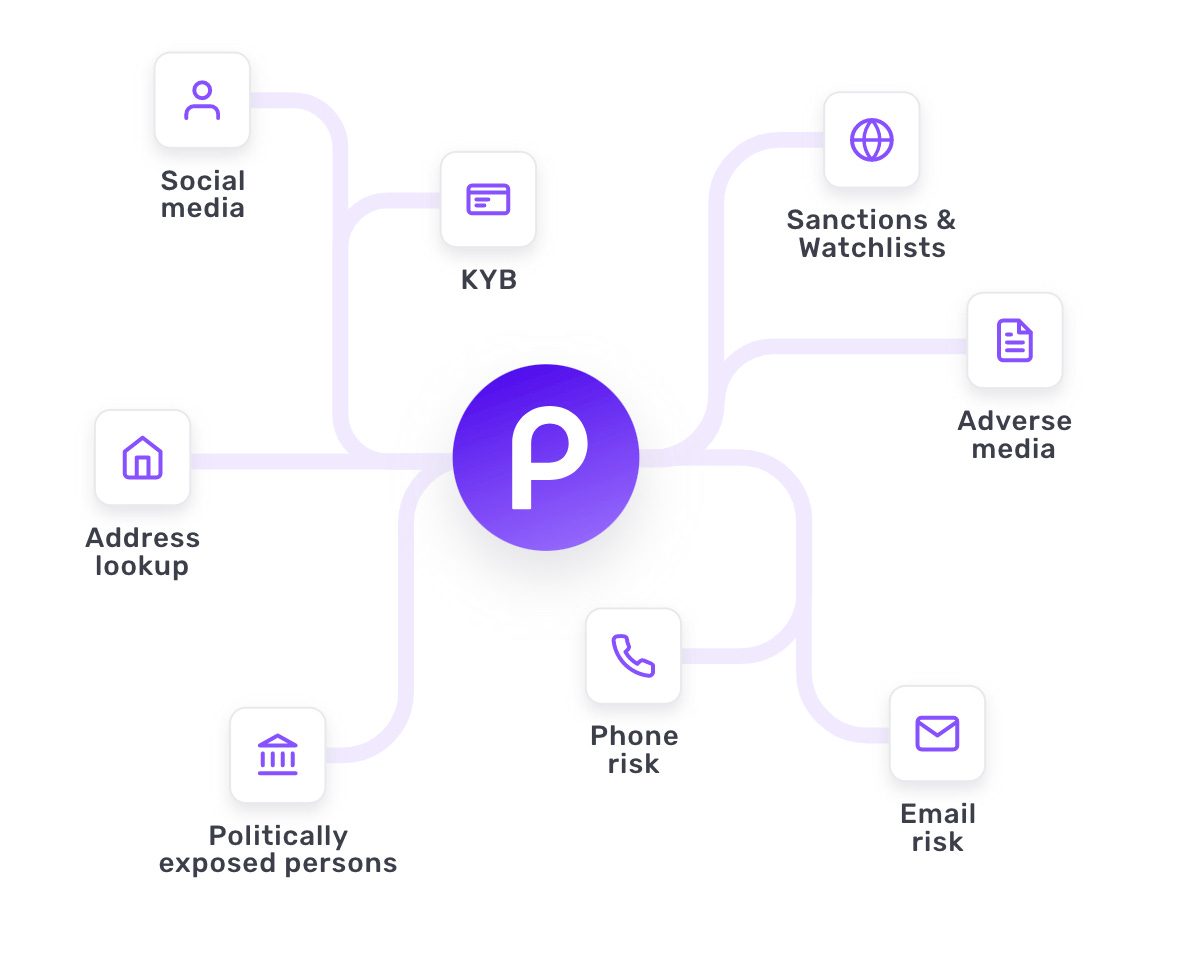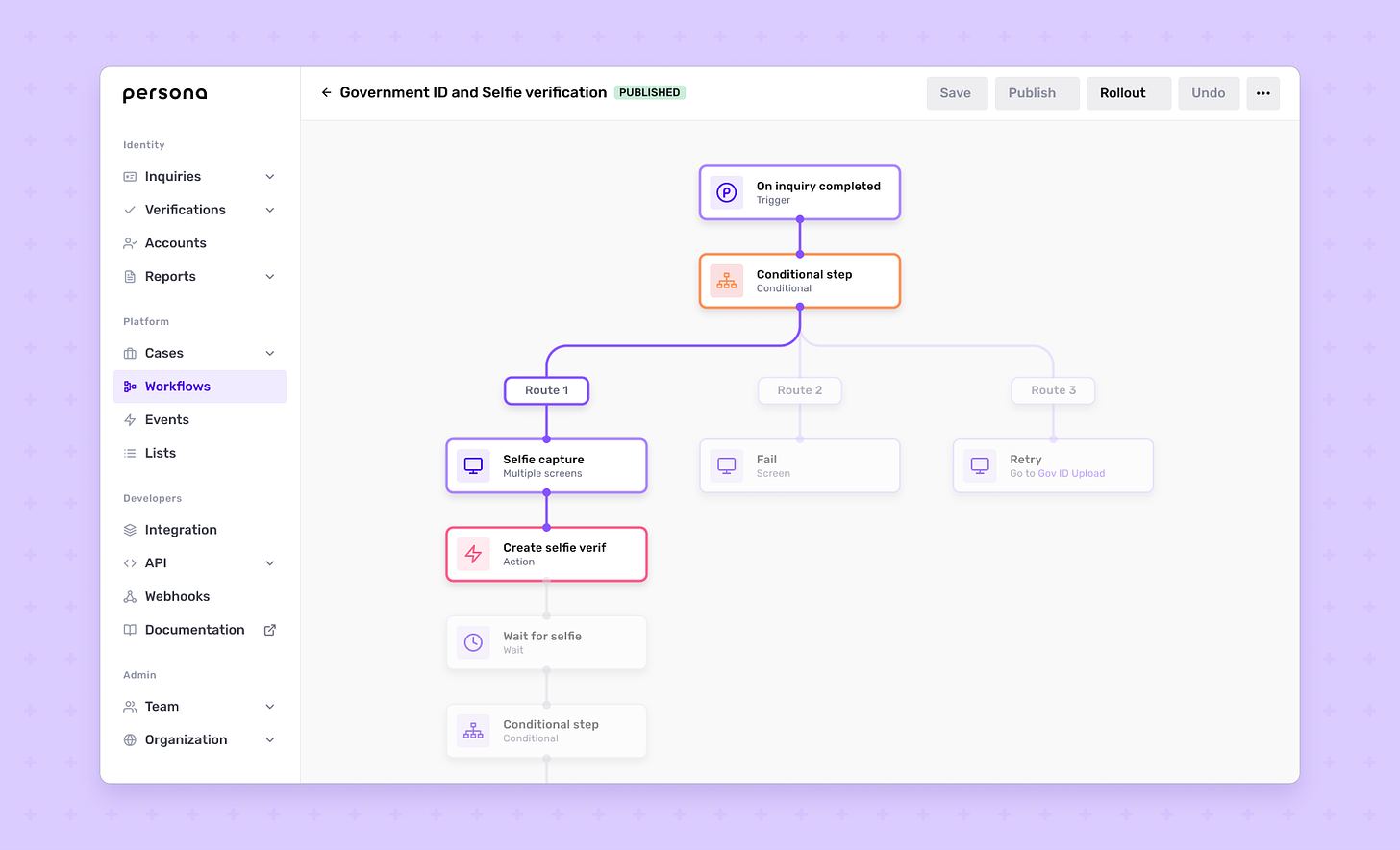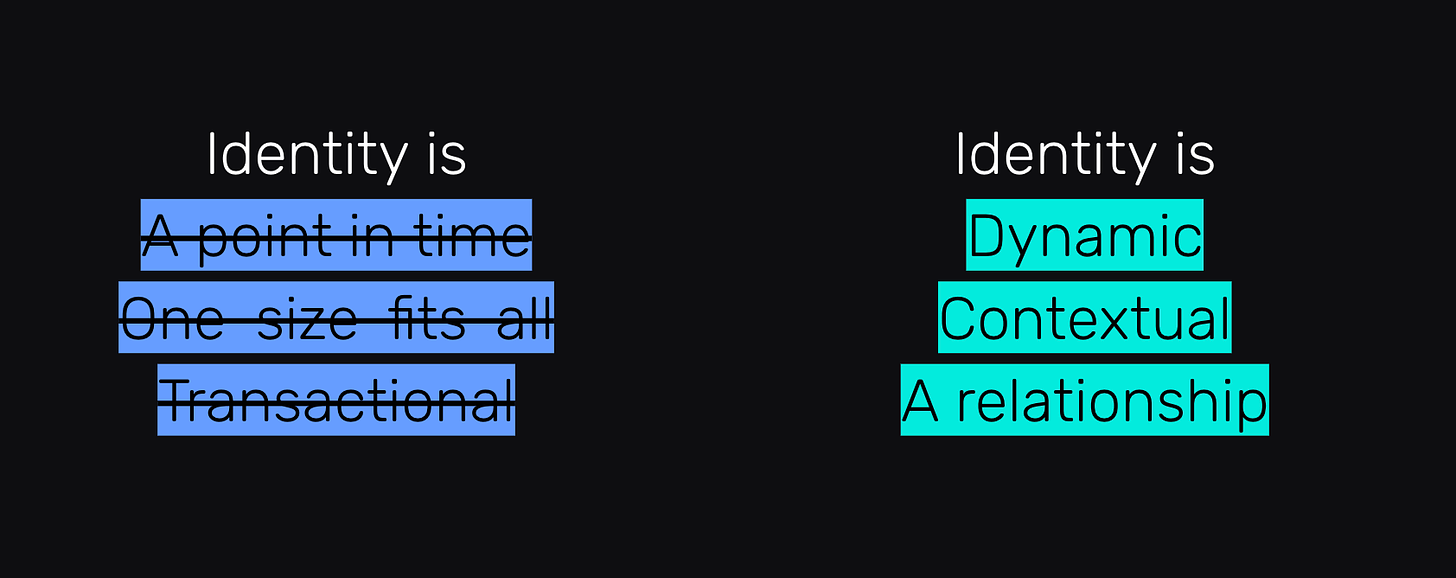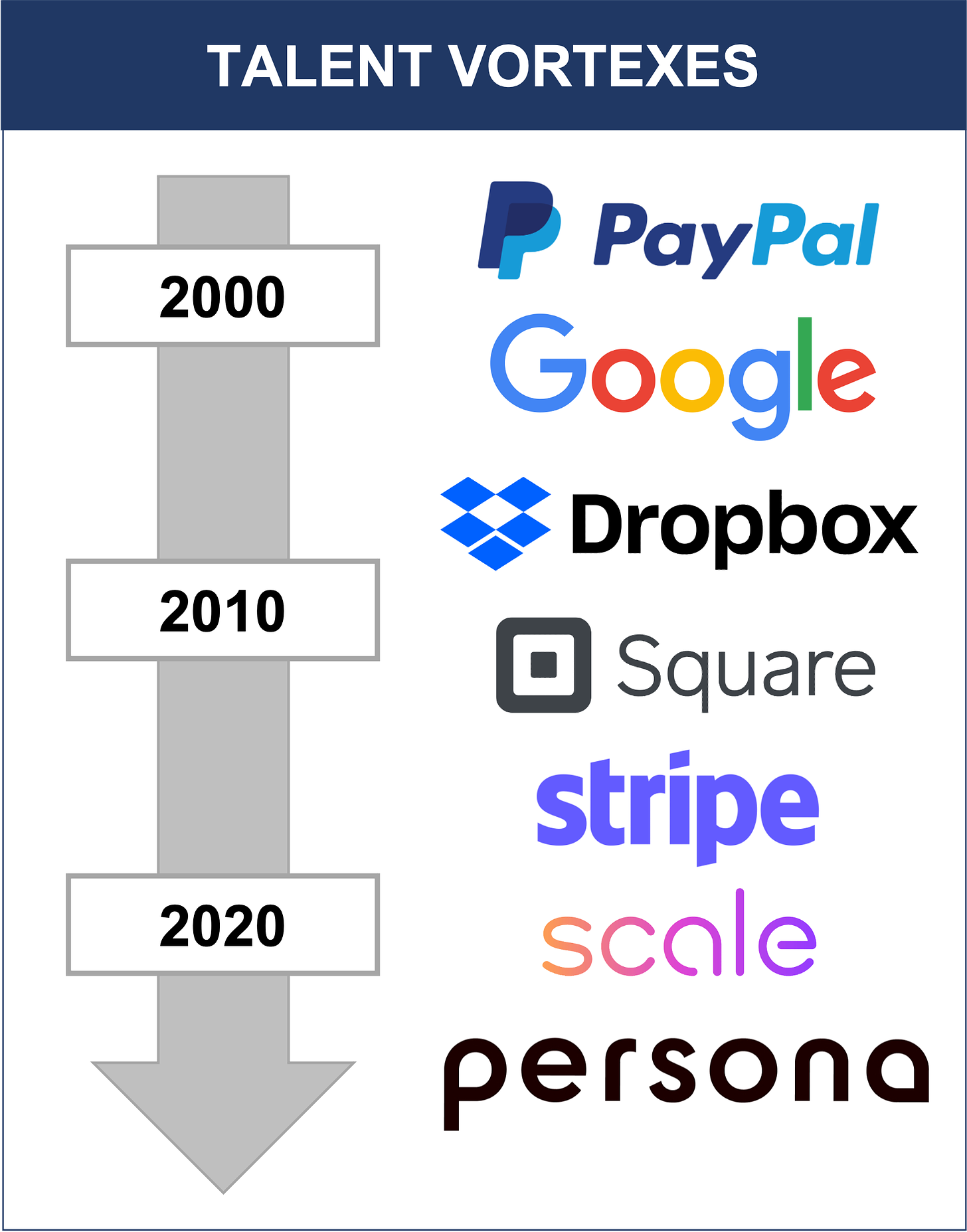Persona: The Building Blocks of Online Identity 👤
How Persona Is Building the Identity Layer for the Digital Economy
This is a weekly newsletter about how tech and culture intersect. To receive Digital Native in your inbox each week, subscribe here:
Hey Everyone 👋 ,
Earlier this year, I mentioned that I’m going to work in more pieces on specific companies, which I’ll pair with pieces on broader themes. I find that writing about innovative individual startups helps make the bigger topics more vivid and tangible.
Identity is a topic I’ve written a lot about on Digital Native, including a three-part series last spring. This week, I’m writing about Persona, which is building the infrastructure for digital identity. Persona is a company we’re lucky to partner with at Index, and I’m writing this piece alongside my colleague Mark.
Let’s dive in to the state of digital identity 👤👤👤
Persona: The Building Blocks of Online Identity 👤
Ernest Cline’s 2011 science-fiction novel Ready Player One—turned into a 2018 film by Steven Spielberg—takes place in 2045, when our planet has been gripped by an energy crisis and rampant climate change. With the physical world crumbling, humans spend most of their waking hours in the OASIS, an immersive virtual reality universe. The OASIS has become mankind’s playground. In the protagonist’s words:
The OASIS is a place where the limits of reality are your own imagination. You can do anything, go anywhere. Like the Vacation Planet. You can surf a 50-foot monster wave in Hawaii, you can ski down the Pyramids, you can climb Mount Everest with Batman.
Then, the protagonist says something profound:
People come to the OASIS for all the things they can do, but they stay for all the things they can be.
They stay for all the things they can be. I think about that sentence a lot.
Today, we’re spending more time than ever online: around the world, the average person spends 7 hours online every day. And as we spend more time online, our online identities become equally as important—or, in some cases, even more important—than our offline identities. This becomes more true with younger generations, the digital natives. Growing up, my online identity was forged in AOL Instant Messenger and Myspace. For today’s kids, it’s Fortnite skins and Roblox avatars and Bitmojis and Discord usernames.
As we hurl toward being a digital-first species, the concept of identity becomes more complex and more urgent; as Paul Sawers puts it in VentureBeat:
Pivotal to the metaverse’s success will be the concept of identity, with people able to traverse between different worlds while retaining the same avatar and individuality—just like they would moving from town-to-town or country-to-country.
And much in the same way as identity and authentication play such an integral part in today’s brick-and-mortar and digital worlds, the metaverse will also require people to claim an identity and permit businesses, organizations, and other virtual citizens to authenticate who they are.
A lot of what I’ve written around identity has been broad strokes—how identity will evolve in the digital age. But more tactically (and more urgently), our burgeoning digital economy needs reliable and scalable identity infrastructure—a platform to underpin the various identities we inhabit in our various online realms.
Enter Persona.
Persona is building identity infrastructure for the digital economy. As we all take on more complex, dynamic, and multi-faceted online identities, Persona becomes the connective tissue stitching them together.
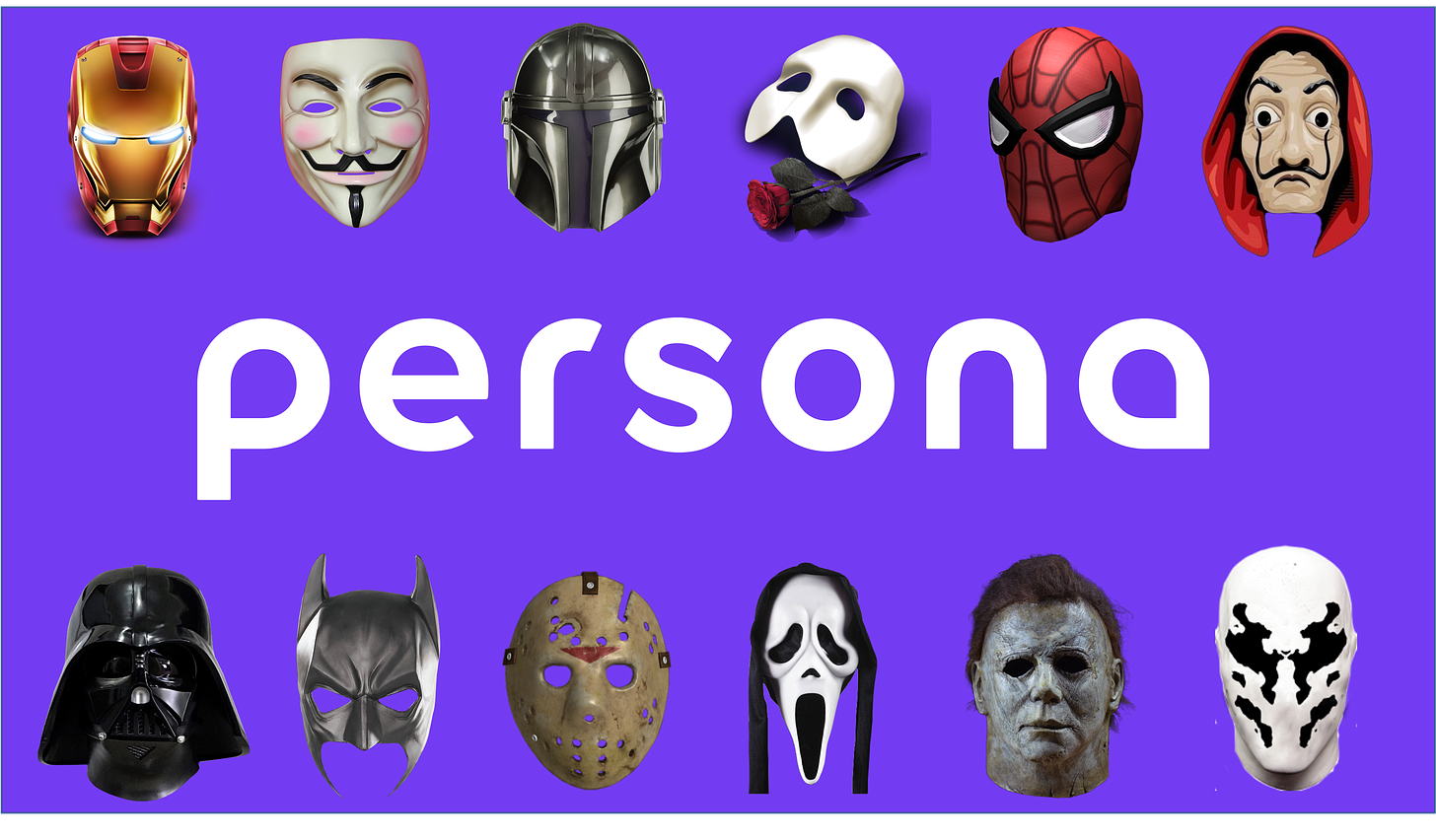
First, let’s take some easy-to-understand examples of why identity matters.
If I’m Airbnb, I have thousands of hosts on my platform. Guests will be staying in these people’s homes, and I need to make sure every host is who she says she is. Likewise for the other side of the marketplace, guests. How do I weed out bad actors, and how do I prevent fraud? Airbnb is a platform built on trust, and trust is inextricably tied to identity.
Or if I’m Uber, how do I ensure that the person picking up passengers is the same person I approved in our system, and not some stranger using their car?
Over the weekend, I went to order dinner on DoorDash and I added a bottle of wine to my cart. DoorDash needed to verify that I’m over 21 and can legally purchase alcohol—you can see here the user flow I went through:
Identity underpins every interaction and every transaction on the internet, and yet the infrastructure of identity was built for an analog world. Social security numbers. Physical addresses. Security questions. In 2022, aren’t there better ways to verify your identity than trying to remember the make and model of your first car?
We live in a world in which 7 billion people own a smartphone with biometric superpowers and a camera that can record 3D face scans. There are more secure ways to manage identity, and that’s where Persona comes in.
When it comes to Persona, there are three things to know:
1️⃣ Persona is built to serve any use case,
2️⃣ Persona is designed to be flexible and powerful while also being easy to use, and
3️⃣ Persona’s vision goes beyond identity verification to identity infrastructure.
Let’s dig in to each.
1️⃣ From Food Delivery to Crypto to Telemedicine
One interesting thing about Persona is the sheer breadth of use cases it serves. It turns out that a lot of different businesses in a lot of different sectors care about identity for a lot of different reasons.
Square used Persona to automate the identity verification of PPP loan applicants during the pandemic. Millions of small business owners relied on PPP loans to stay afloat during COVID, but these merchants needed to quickly and easily prove eligibility. Persona powered that workflow, allowing Square to distribute over $1B in government loans.
As the Square example alludes to, fintech is a major category for Persona. This makes sense: moving money around relies heavily on knowing who the sender is and who’s on the receiving end. Brex, for instance, uses Persona on its cash management product, Brex Cash, to confirm the identity of customers and to detect fraud.
An adjacent space is crypto. Crypto is uniquely interesting when it comes to identity, since crypto is built largely on the idea of pseudonymity. I like how Jackson Dahl puts it: “Pseudonymity allows identity to become contextual rather than fixed. In that regard, pseudonymity, unlike anonymity, is a spectrum and a vast design space.” Crypto is changing how people live and work online. One worker recently declared: “Over the next year(s), I’ll likely transform from a career professional into a pseudonymous agent across a variety of projects.”
BlockFi, one of the largest crypto companies, works with Persona to comply with Know Your Customer (KYC) and Anti-Money Laundering (AML) regulations. And as crypto continues to shape online identity in new ways, new use cases will emerge for Persona’s identity products.
To return to the example of food delivery above, Persona works with many customers in the food delivery space to verify couriers. By creating customized onboarding flows, businesses are able to speed up the process while minimizing fraud.
Persona is also built to serve more complex use cases:
Remote, another of our investments at Index, lets companies hire employees or contractors from anywhere on the planet. In a world of global, distributed teams, the need to manage payroll, benefits, and taxes across borders is exploding. There’s a recurring theme on Remote’s website: global HR, international payroll, in every continent. Remote serves employees and contractors in 150 countries, and it requires identity verification compatible with every single one of them. Persona covers 200 countries and 20 languages, and configures into Remote’s onboarding for workers.
Healthcare is among the most nuanced sectors when it comes to identity, and telemedicine is making it even moreso. In an effort to stem the rise of prescription drug abuse, states enacted drug identification laws that require identity verification before dispensing medication. Companies like SimpleHealth use Persona to verify users for prescription delivery.
There are other dozens of other interesting applications for Persona: UrbanSitter, a marketplace connecting parents and babysitters, uses Persona to ensure trust and safety; Rippling, a one-stop-shop for managing employee operations, uses Persona to prevent bad actors from taking over employee accounts on its platform; Outdoorsy, an RV rental company, uses Persona to verify renters.
I came across one more interesting use case last month. A friend bought a Tesla, and the car was delivered to her house. Tesla required her to electronically sign for her new vehicle.
Tesla’s goal was to ensure that the person receiving the car was the same person the vehicle is registered under. My friend texted me as she went through the user flow—she’d seen that Persona was the one powering Tesla’s identity verification.
2️⃣ Identity Legos
Before founding Persona, Rick Song helped build the systems to manage identity at Square, and Charles Yeh worked on data infrastructure to help safeguard Dropbox’s most sensitive data. Rick and Charles experienced firsthand the need for Persona, so they set out to build the product they wished already existed.
From the beginning, Rick and Charles knew their product needed to be flexible. When you have use cases as varied as those above, your product needs to be able to be quickly customized. So Rick and Charles made identity configurable.
You can think of Persona as identity legos—building blocks that can be assembled and broken down and reassembled in new ways.
Customers need to be able to adapt Persona to the needs of different users.
Coursera is one of the largest online learning platforms in the world, with 82 million registered learners. But that scale means that Coursera is used by students in very different ways: some learners turn to Coursera in place of a bachelor’s degree, while others use Coursera only as a casual way to learn an interesting subject.
Coursera uses Persona to verify learners’ identities before delivering course credentials. But those two user profiles—the individual looking to complete a university-accredited course, vs. the individual looking to learn just for fun—shouldn’t go through the same verification process. Coursera is able to vet learners differently based on context.
There are various component parts of identity, and not all parts are needed in all scenarios. Persona’s elegance comes from letting customers pick and choose.
Sometimes you might just need a government ID check and an address lookup. In other cases, you might want to add a live selfie. Brex, for instance, uses selfie video verification to provide an additional layer of fraud deterrence. The entire flow can be processed in under 10 seconds.
Critically, Persona is built to be accessible: you don’t need to rely on your engineering team to set things up. Persona offers a no-code, drag-and-drop interface that uses if/then logic for custom workflows.
You can add specific rules into the workflow. Sonder, for instance, is a hospitality company with 5,000 places to stay in 28 cities. In order to book a stay, Sonder requires identity verification. Sonder uses Persona’s Workflows product to bake in specific rules: for instance, a rule might be “flag expired government IDs for manual review.”
Brex, meanwhile, customizes Persona with custom icons, text colors, and theme changes. Since the use case is consumer-facing, the goal is to create a delightful and consistent user experience. Persona is built to be robust yet accessible, powerful yet flexible.
3️⃣ Identity Verification Infrastructure
One thing Rick likes to say is that identity isn’t a single point in time, or one-size-fits-all, or transactional; identity is dynamic and contextual. Identity is a relationship.
Persona aims to go far beyond identity verification. Rather, Persona aims to be the one-stop-shop for managing the identity lifecycle: collection, verification, investigation, decision-making.
Customers are turning to Persona for the most critical parts of identity. Sonder, for instance, sought a partner that would prioritize its users’ data privacy. What’s called PII—Personal Identifiable Information—can be a delicate thing. Persona is able to act as Sonder’s PII custodian, securely storing, managing, and handling all data.
As a healthcare company, SimpleHealth needed technical, physical, and administrative safeguards in place for protected health information (PHI). Persona is SOC 2 Type II certified and HIPAA compliant, working with SimpleHealth to manage identity end-to-end.
The goal isn’t to offer a point solution for identity, or to solve a single painpoint. Persona’s vision is to build the identity layer that facilitates trust between businesses and individuals, making it easy for businesses to build tailored identity programs and subsequently making the identity experience more personalized, secure, and accessible for individuals.
🌪 Final Thoughts: Talent Vortexes
My partner Mark often talks about talent vortexes. Talent vortexes are the companies that attract the best of the best. They have an enormously high bar for talent, and they begin to accumulate world-class engineers and product leaders and salespeople and designers. Excellent people attract other excellent people, and before you know it, these companies have become magnets for the top 1% of startup talent.
We’ve seen this play out over the years, from PayPal in the 2000s to Stripe in the 2010s. We’re seeing it happen again at Persona.
Dozens of members of Persona’s team hail from other talent vortexes like Square and Dropbox, Plaid and Uber; some of the best engineers in Silicon Valley are joining Persona. When I ask members of the team (“Personerds”) what attracted them to Persona, they point to the same value: empowerment. The same ethos that powers Persona’s mission to build flexible and configurable tools for customers powers Persona’s culture for its employees: meritocratic, product-obsessed, with a bias to building. Everyone is an owner.
This is the part where I tell you that Persona is hiring across all functions—Engineering, Design, Product, Sales, Marketing, Operations. You can check out their Careers page here.
And if you’re interested in using Persona for your company, you can contact them here 📬
Persona’s mission is to humanize online identity—businesses should be able to manage distinct identities to ensure trust, all while still enabling individuals to try out new forms of self expression and control how much of their lives to share. Identity should be built for all use cases; identity should be flexible, yet powerful; and identity should encompass all aspects of the identity lifecycle.
Identity used to be rigid, but our digital worlds require more fluidity. We need new rails for a new economy—identity that is relational, contextual, dynamic. Persona is bringing identity into the 21st century.
Sources & Additional Reading
Thank you to my partner Mark for co-writing with me, and to Rick, Christie, and Evelyn from Persona for their help with this piece
Identity and Authentication in the Metaverse | VentureBeat
What Is the Metaverse? | WIRED
Related Digital Native Pieces
Last year’s three-part series on identity in the metaverse:
Thanks for reading! Subscribe here to receive Digital Native in your inbox each week:









